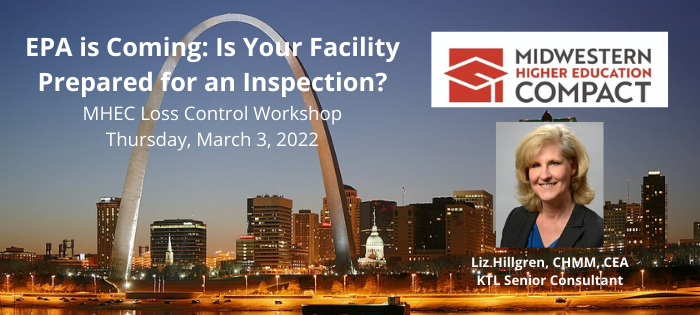
KTL Presentation on EPA Inspections Featured at Loss Control Workshop
KTL is excited to be joining the Midwest Higher Education Compact (MHEC) as a featured presenter at the 24th Annual Loss Control Workshop live and in-person in St. Louis, Missouri. This workshop is open to all interested institutional representatives participating in MHEC’s Master Property Program.
KTL’s presention is part of the workshop’s technical agenda:
EPA Is Coming: Is Your Facility Prepared for an Inspection?
Thursday, March 3, 2022
3:30-4:30 pm CT
In recent months, regulated facilities have experienced an uptick in U.S. EPA information surveys and multimedia inspections. KTL’s Liz Hillgren, CHMM, CEA, will present guidance on steps you can take to prepare for inspections and minmize your risk of compliance findings and enforcment actions.
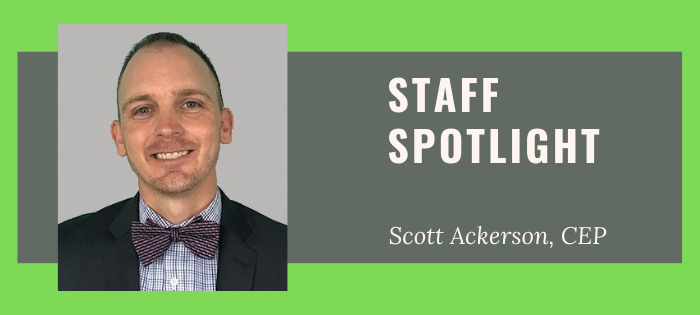
Comments: No Comments
Staff Spotlight on Scott Ackerson, CEP
Get to know our KTL team! This month, we are catching up with KTL Senior Consultant Scott Ackerson. Scott is a Certified Environmental Professional (CEP) with technical expertise in international environmental compliance and environmental system design and nearly 20 years of professional experience in managerial and strategic leadership supporting governments, private industry, and NGOs. He is based out of Arlington, Virginia.
Tell us a little bit about your background—what are your areas of expertise?
During my career, I’ve worked with Peace Corps in Morocco and United States Agency for International Development (USAID), Centers for Disease Control and Prevention (CDC), and Global Fund as an Implementing Partner. In addition, I’ve lived and worked in over 17 countries working with various Ministries of Health to provide technical assistance in areas such as developing health care waste management (HCWM) strategies/framework and environmental systems for donor counterparts to strengthen environmental compliance in areas including general hygiene; waste management (non-hazardous and hazardous); health and safety; water, sanitation, and hygiene (WASH); and HIV/AIDS prevention.
Some highlights over my career before joining KTL include the following:
- While working on the USAID-funded Supply Chain Management System (SCMS) project, I developed and successfully implemented large-scale organizational initiatives that have played integral roles in achieving the organization’s mission.
- I was assigned to support the Liberia Ministry of Health to establish a waste management strategy plan to dispose of unusable pharmaceutical waste in the supply chain. The assignment took about three months to successfully develop a waste management strategy plan that was used to properly collect and dispose of around 700,00 tons of unusable pharmaceutical waste.
- In 2013, I led a team of three international technical experts to develop a HCWM system for the U.S. President’s Emergency Plan for AIDS Relief (PEPFAR)-supported Voluntary Medical Male Circumcision (VMMC) campaign in the Kingdom of Eswatini. The country required a proactive solution for the safe handling and disposal of more than 30,000 kg (66,000 lbs) of health care risk waste generated during its one-year lifespan. In collaboration with the Environmental Health Department within the Ministry of Health, the World Bank, and other relevant partners, the team was able to develop a sound policy that defines clear objectives, activities, roles and responsibilities, timelines, infrastructure, and control requirements for the execution of a new and improved national HCWM system. In addition, the team developed a VMMC HCWM toolkit for the safe and proper disposal of male circumcision hazardous waste.
What types of clients do you work with? What are the biggest issues you see them facing right now?
I’m currently part of an incredible KTL Environmental Compliance Support (ECOS) team that provides consulting services as part of the USAID ECOS contract. The ECOS contract provides USAID staff and Implementing Partners worldwide with technical, educational, and knowledge management assistance to facilitate compliance with 22 CFR 216, Foreign Assistance Act (FAA) Sections 117/118/119, regulatory requirements, and Executive Order and policy objectives.
In addition, the KTL ECOS team offers the USAID’s Bureau Environmental Officer (BEO) of Global Health (GH) and other BEOs a consistent, quality approach to environmental compliance to minimize duplication of systems and effort, facilitate the sharing of lessons learned, reduce compliance risks, and other related services.
The most significant issue facing USAID’s BEO, much like many organizations in the public and private sector, is the lack of funding to ensure staff and Implementing Partners have the tools and knowledge to implement environmentally sound projects.
What would you say is a highlight of your job?
I enjoy interacting with the KTL ECOS team to solve complex problems, while providing trainable moments for USAID staff and Implementing Partners.
What do you like to do in your free time?
I like traveling to places, learning about new cultures, and enjoying the food. Of course, I also enjoy the fine arts (i.e., symphony, musicals, and museums). But most of all, I enjoy life’s simple things with my partner, friends, and family, no matter the occasion.
Read Scott’s full bio.

Comments: No Comments
Staff Spotlight on Meghan Stenslien
Get to know our KTL team! This month, we are catching up with KTL Consultant Meghan Stenslien. Meghan has a diverse background working in food safety; quality; and environmental, health, and safety (EHS) compliance and excels at managing compliance and certification programs. She is based out of LaCrosse, Wisconsin.
Tell us a little bit about your background—what are your areas of expertise?
I have my bachelor’s degree in biochemistry and began my career performing quality and environmental lab analysis for food manufacturers. I quickly realized that I have a passion for designing and implementing management systems, helping companies meet their certification requirements, and working with them to further improve their current systems.
What types of clients do you work with? What are the biggest issues you see them facing right now?
I currently work with clients whose needs span both KTL’s food safety and EHS disciplines. Across the board, I am seeing issues with staffing. A combination of COVID-19 highlighting a shortage of skilled labor throughout the workforce and the need to stretch budgets further has created a “perfect storm” that needs to be addressed—and soon for many organizations. I am proud that KTL has the opportunity to work with these companies—many of which are struggling to get everything done—to implement efficient and quality programs that will sustain them through these times.
What would you say is a highlight of your job?
Variety is the spice of life for me! I enjoy the broad range of clients and services that I get to work with in my role at KTL. Each day presents new challenges and new opportunities to not only create lasting solutions for our clients, but also expand my own knowledge base. I feel fortunate to have so many experienced subject matter experts as colleagues whom I collaborate with daily.
What do you like to do in your free time?
I enjoy spending time with my wonderful 16- and 14-year-old daughters, my husband, and our pets. I love hiking and exploring uncharted places; traveling and experiencing new cultures; baking for family and friends; working on our home renovation; expanding my indoor garden; and doing crafts.
Read Megan’s full bio.
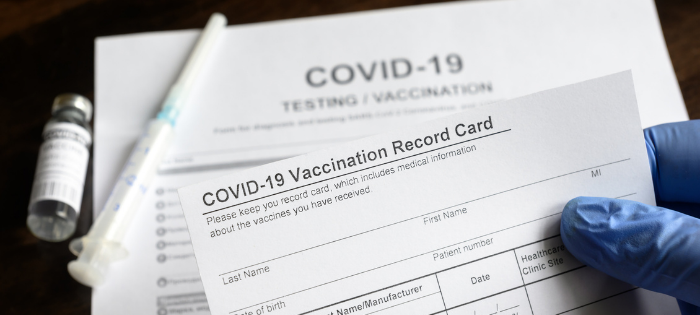
Comments: No Comments
COVID Vaccine Mandate: Update for Employers
The Health and Economic Recovery Omnibus Emergency Solutions (HEROES) Act was passed on May 15, 2020 to respond to the COVID-19 outbreak and its impact on the economy, public health, state and local governments, individuals, and businesses. Part of this bill involves protecting workers by requiring the Occupational Safety and Health Administration (OSHA) to issue an enforceable emergency temporary standard (ETS) that covers all workers from COVID-19 infections.
OSHA announced the COVID-19 Vaccination and Testing ETS on November 4, 2021. Just one day later, the Fifth U.S. Circuit Court of Appeals put a temporary halt to the ETS by granting an emergency motion/stay pending an expedited review because of “cause to believe there are grave statutory and constitutional issues with the [ETS]”. November 12, 2021 marked another court ruling against the ETS vaccine directive. The court ordered that OSHA “take no steps to implement or enforce” the ETS “until further court order.”
According to the OSHA website, “While OSHA remains confident in its authority to protect workers in emergencies, OSHA has suspended activities related to the implementation and enforcement of the ETS pending future developments in the litigation”–leaving many employers questioning how to proceed.
ETS at a Glance
The COVID-19 ETS requires employers with more than 100 employees to develop, implement, and enforce a mandatory COVID-19 vaccination policy or a policy requiring employees to choose to either be vaccinated or undergo regular COVID-19 testing and wear a face covering.
According to Deputy Assistant Secretary of Labor for OSHA Jim Frederick, “While vaccination remains the most effective and efficient defense against COVID-19, this ETS will protect all workers, including those who remain unvaccinated, by requiring regular testing and the use of face coverings by unvaccinated workers to prevent the spread of the virus.”
Additional provisions of the ETS include the following:
- Determine, obtain acceptable proof of, and maintain accurate records of the vaccination status of every employee.
- Provide paid time off to workers to get vaccinated and to recover from any side effects.
- Require each worker who is not fully vaccinated to test weekly for COVID -19. Note: Employers are not required to pay for testing.
- Ensure every employee who has not been fully vaccinated wears a face covering when indoors or in a vehicle with another person for work purposes. Note: Employers are not required to pay for face coverings.
- Require employees to provide prompt notice when they test positive for COVID-19 so they may be removed from the workplace (whether vaccinated or not) until they meet required criteria to return to work.
These new mandates may also be accompanied by higher risk of OSHA enforcement and significantly increased penalties depending on the status of the Build Back Better Act (BBBA) (see related article).
Compliance Deadlines
OSHA has recently extended the comment period for the COVID-19 ETS by 45 days to January 19, 2022. If the ETS moves forward—which is still an unknown at this time—covered employers would have 30 days to develop, implement, and enforce their COVID-19 vaccination and/or testing policy. Employers then have 60 days for employees to actually be fully vaccinated or begin testing requirements. This ETS also serves as a proposal for normal rulemaking of a final standard.
Preparing to Comply
Many legal experts recommend employers prepare to comply regardless of ongoing court challenges and litigation. Corbin Carter, an attorney with Mintz in New York City, said in a Society for Human Resource Management (SHRM) article, “The Supreme Court may ultimately weigh in. But employers likely cannot await a court ruling on the new rule’s fate before properly engaging in the appropriate tasks—convening stakeholders, reviewing the relevant rules, assessing options—given the rule’s tight timeline.”
When—or if—this mandate goes forward, tracking and documentation of vaccination and/or testing status will be a key part of complying with standards. This is not unlike other records OSHA requires for training, inspections, incidents, etc. A document/compliance management system (CMS) can allow for easier tracking and access to employee records to demonstrate compliance with the ETS. If your company is preparing for the ETS—or if you are simply interested in developing a strong, organized CMS—KTL can integrate our expertise in OSHA regulatory compliance into our SharePoint data management solutions to develop a system that will meet your organization’s needs.
OSHA intends to offer robust compliance assistance to help businesses implement the ETS and will continue to monitor COVID-19 infections and deaths as the pandemic evolves to change measures, as needed. Get more information and guidance from OSHA on the COVID-19 Vaccination and Testing ETS.

Comments: No Comments
Build Back Better: OSHA Enforcement
After months of negotiations, the House of Representatives passed the Build Back Better Act (BBBA), H.R. 5376—also known as the reconciliation bill—on November 19, 2021. The BBBA is intended to fulfill aspects of President Joe Biden’s Build Back Better Plan. And while some would consider the most recent version less ambitious than previous iterations, it retains many major provisions related to social programs, taxes, climate change, family aid, and worker safety.
Amendments to the Occupational Safety and Health Act
As currently proposed, the BBBA would include the first amendment to the Occupational Safety and Health (OSH) Act in nearly 20 years, when it was updated to reflect bioterrorist threats to workers in the aftermath of 9/11. This includes increasing funding to make significant improvements in workplace safety protection for American workers:
- $707 million to Occupational Safety and Health Administration (OSHA) for carrying out enforcement, standards development, whistleblower investigations, compliance assistance, funding for state plans, and related activities within OSHA.
- $133 million to Mine Safety and Health Administration (MSHA) for carrying out enforcement, standard setting, technical assistance, and related activities.
Perhaps even more immediately impactful to industry, the BBBA would also include significant increases to OSHA’s maximum penalties:
- Penalties for serious violations would increase from a current maximum of $13,653 (inflation adjusted) to $70,000.
- Penalties for willful, repeated, and failure-to-abate violations would increase from a maximum of $136,530 (inflation adjusted) to $700,000 (and from a minimum of $9,753 to $50,000).
Note that these are maximum penalties on a per-day basis. Small- to medium-size businesses would likely incur lesser fines based on the four factors OSHA considers when deciding the actual penalty level, including:
- Gravity of the violation
- Employer’s size
- Employer’s “good faith”
- Employer’s history of compliance
According to former OSHA head David Michaels, “Many large employers treat current OSHA fines as cheaper than the cost of a safety consultant. This dramatic increase will save lives by encouraging firms to eliminate hazards before workers are hurt.”
House Education and Labor Committee Chair Bobby Scott (D-VA) agreed with these sentiments in a September 9, 2021, press release, stating, “As part of the Build Back Better Plan, workers’ rights are strengthened with provisions to apply civil monetary penalties for labor law violations and by updating the dollar amount of worker safety penalties so they are large enough to serve as an adequate deterrent.”
Get Ready…
There may still be a lot of work to do for the Senate to pass the BBBA—and what the Act’s final provisions will include is still not entirely certain. However, the latest iteration provides a good picture of where OSHA is headed. The federal government recognizes that OSHA’s penalty levels are significantly lower than other agencies and, correspondingly, that OSHA’s rigor in application of penalty has been much lower.
Over 50 years since the OSH Act was passed, the government is trying to remedy both. The BBBA changes would authorize OSHA to enforce high enough penalties to significantly impact businesses that violate the law and injure or kill workers.
While OSHA doesn’t have the resources to audit or fine everyone, the agency will likely make an example of a few major violators to deter others from non-compliance. The best way to get ready for this potential wave of new enforcement is to be prepared:
- Make sure you have the processes, programs, and systems in place—and documented—to ensure you are always protecting employees’ safety and health and meeting OSH Act requirements.
- Establish a centralized location, like a Compliance Management System (CMS), to track and manage all safety-related information to not only help ensure going compliance but to also provide the documentation required should an inspection occur.
- Understand what to expect from an OSHA inspection and prepare your staff to respond appropriately and locate requested documentation.
And, as always, good faith goes a long way. If there are issues, fix them and document them. Abatement efforts matter.

Comments: No Comments
Staff Spotlight on Samantha Edwards
Get to know our KTL team! This month, we are catching up with KTL Consultant Samantha Edwards. Samantha has in-depth knowledge of FDA food safety regulations as they apply in laboratory, manufacturing, and packaging settings–and specialized expertise in fermentation science. She is based out of Asheville, NC.
Tell us a little bit about your background—what are your areas of expertise?
I received my bachelor’s degree in food science and technology from Virginia Tech in 2013. I started my career in meat packaging and moved into fermentation science. I also have some experience in nutraceuticals and juice manufacturing. My expertise is in food safety and quality management.
What types of clients do you work with? What are the biggest issues you see them facing right now?
I work with food manufacturing and food packaging clients. The biggest issue I am seeing in the industry currently is staffing shortages. These staffing issues can negatively impact the food safety management system (FSMS) and how the company is able to fulfill food safety and quality commitments and requirements. Our food safety team continues to support our clients through these challenging times by assisting with hiring and onboarding, training employees to understand and fulfill food safety responsibilities, conducting remote and onsite assessments of the FSMS to help ensure compliance with requirements, and even stepping in as interim food safety team leaders when needed.
What would you say is a highlight of your job?
The highlight of my job is getting to work with so many people with different professional backgrounds. If there is ever something I want to learn more about, I know I have resources within KTL I can reach out to.
What do you like to do in your free time?
In my free time, I am involved in a running club. We run three times a week and run a few races a month together. I also spend as much time as possible outside with my dogs enjoying the Blue Ridge Mountains that we get to call home.
Read Samantha’s full bio.
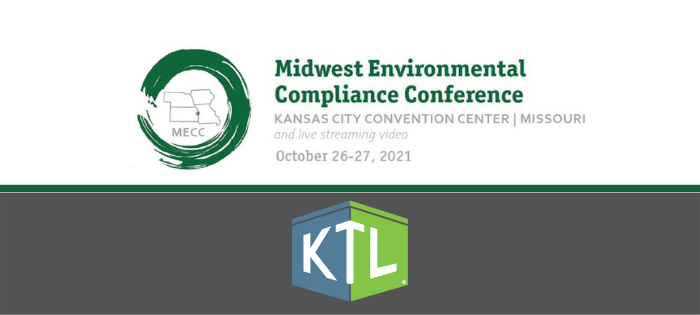
MECC 2021: KTL Presentation on EPA Inspections
KTL will once again be sponsoring the Midwest Environmental Compliance Conference (MECC) held by live streaming video October 26-27. MECC takes a fresh, regional approach to the increasingly difficult task of environmental compliance, permitting, enforcement, and other critical environmental issues that impact Midwest facilities and institutions. KTL will a featured presenter as part of the technical agenda:
Preparing for U.S. EPA Inspections in Region 7
Tuesday, October 26
2:00 pm – 2:40 pm CT
In recent months, regulated facilities have experienced an uptick in U.S. EPA information surveys and multimedia inspections. KTL’s Becky Andersen will present guidance on steps you can take to prepare for inspections and minmize your risk of compliance findings and enforcment actions.
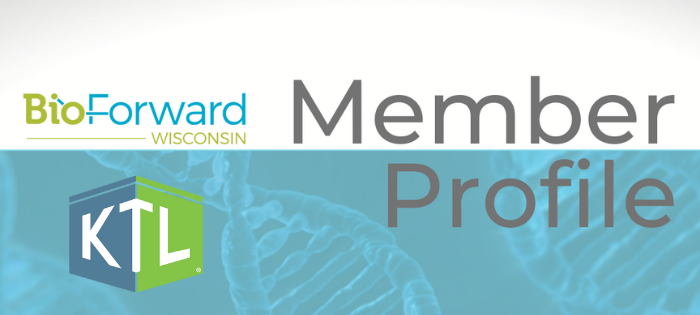
Comments: No Comments
BioForward Wisconsin: Profile on KTL
BioForward Wisconsin recently reached out to KTL to tell more of our story and to highlight how our company is helping to support the rapidly growing biotech/biohealth industry. Read our recent interview to learn more about KTL’s work with BioForward, its member companies, and the industry overall.

Comments: No Comments
Staff Spotlight on Andy Smith
Get to know our KTL team! This month, we are catching up with KTL Senior Consultant and Partner Andy Smith. Andy has over 10 years of experience providing project oversight, technical support, and IT solutions on a variety of EHS and engineering projects for a wide range of clients and industries. Andy is based out of our Madison, WI office.
Tell us a little bit about your background—what are your areas of expertise?
I started working at KTL in 2011, mainly to support a large data gathering and management project. From there, I managed to prove myself useful in other areas and stuck around. Since joining KTL, I’ve worked on a wide variety of projects and developed plenty of IT skills, including SharePoint development, GIS, statistics/data analysis, etc. My primary areas of expertise these days would be leveraging those IT skills on projects involving asset retirement obligations (AROs), EHS and regulatory compliance, and general project management.
What types of clients do you work with? What are the biggest issues you see them facing right now?
Most of my client work has been focused on the private sector, with the bulk of my current time spent with chemical manufacturing companies. However, I have also worked extensively with transportation and manufacturing companies.
Overall, the most common issue the clients I work with face is managing regulatory, environmental, and workplace safety risks while balancing the need to maintain and manage a productive company.
What would you say is a highlight of your job?
I enjoy working on a wide variety of projects and continuously improving the work KTL performs. Sometimes this will show up in doing a task more efficiently than we had in the past. Other times it might mean leveraging an IT platform like SharePoint or management system approach to make the work considerably more repeatable and manageable.
What do you like to do in your free time?
I bike a fair amount and play semi-convincing soccer regularly. Beyond that, my free time is consumed by books, random stuff, and hanging out with the cat.
Read Andy’s full bio.
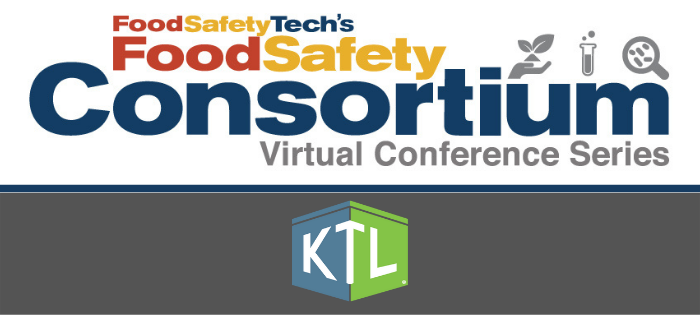
Food Safety Consortium: KTL Presentation on How to Respond to Recalls
The Food Safety Consortium Fall Edition is kicking off this October with five weekly sessions featuring critical thinking topics that have been developed for both industry veterans and knowledgeable newcomers. KTL will be a featured presenter during the Recalls: Trends and Analysis episode on Thursday, October 14:
How to Respond to Recalls
Thursday, October 14
1:10 pm – 1:55 pm ET (includes Q&A)
Presented by KTL Senior Consultant Roberto Bellavia
